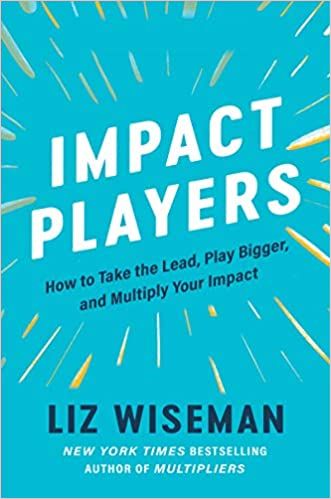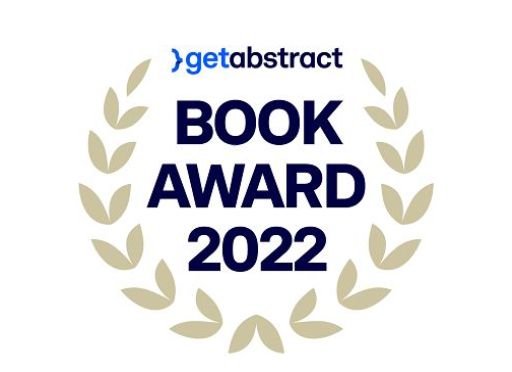“Five Practices Distinguish ‘Impact Players’ from All Other Equally Capable Employees.”

Liz, in Impact Players, you look at three types of employees: those who do their jobs well, those who tend to underperform, and those who both groups should be able to look up to – those who achieve more and make a difference. Can you briefly explain how you narrowed them down for your research?
Liz Wiseman: Well, I think there are some essential things to understand before one adopts my suggestions on becoming an Impact Player. My question was: In a room full of equally intelligent, talented, hardworking people, why are some people making a big difference and other people stuck going through the motions or – worse – under-contributing? We were trying to put a microscope on the practices that distinguish equally capable, hardworking, and rock-solid contributors and people who are making an extraordinary impact. The best way to find out what makes the difference is to ask their colleagues, especially the managers. That is what we did. And when we received the responses from the 170 leaders we solicited, we grouped them. We found that five behaviors or practices distinguish what we call “Impact Players” from all other equally capable employees.
These five practices are “Do the job that’s needed,” “Step up and take the lead, then step back and support others,” “Finish stronger,” “Ask and adjust,” and “Make Work Light.” Before we dive a bit deeper, I’d like to clarify: Does it already distinguish an Impact Player if they know how to apply one of the practices – or is it the ability to use them all at the right time?
The Impact Players we studied in aggregate had these five distinctions in common. On average, they had 3.4 of those practices. So, it was rare that someone ticked all five boxes. It’s like many things: If your weight balance is over on the Impact Player side, you will probably be working that way and perceived that way.
In the end, it all comes down to your mindset, not to types of people.
For example, I can tell you about times when I was operating in Impact Player mode, thinking this way, working this way, creating value, and receiving value this way. But I can also point to phases in my career where I’ve gotten myself into this common contributor mindset of “let me do my job” or wait for someone to clarify. My finding is that there are modes of thinking and working that we tend to move in and out of based on the environment around us, the team we’re on, and the leader and mentors we have. My goal with this book was to help people to recognize where they can use more of this Impact Player mindset and how they can benefit from it in multiple ways. Because when they do, they will give work of higher value as difference makers, not position holders.

In the book, you say that you found that work, in general, will feel a lot better, too.
Exactly! It’s going to be exhilarating, not exhausting. What delighted me in the research was that Impact Players make work “light” for other people and are also light-hearted, fun, and easy to work with. It’s all about that fifth practice we identified: Impact Players not only lend a helping hand – that’s not surprising – but are a low-maintenance kind of people, and working with them feels light.
Can you give an example here?
Imagine you go to a co-worker’s office to ask for a report or some data. And you know it will take 10 minutes, not two hours. They’re not going to make you listen to an extensive lecture on data sequencing or delegate you to someone else. They’re just going be like, “Hey, good to see you, what do you need? Ah. Well, let me see. Here’s what we’ve got. Is this what you need? If you need more, let me know.” Such encounters are easy and delightful. And we all gravitate toward these people in our organizations because of their energy and illumination.
Take-Aways:
- Impact Players are low-maintenance people, and working with them feels light – they don’t dominate teams or conversations.
- Impact Players surround themselves with people that provide good intel.
- Impact Players are aggressively stepping up, but they’re stepping up in service to something on the organization’s agenda, so their leader might value their initiative.
One might have assumed that Impact Players are primarily brutal lone wolves, cold calculators with an adamant will and zero empathy.
That’s why, when we started the study, I had a little body armor on. I wondered if many of them were going to be prima donnas and even some bullies that are superstars; they know it, everyone knows it, and they exercise that power.
The Jack Welch kind of guy?
Yes. People other people feared. But it turned out they weren’t people who dominated teams or dominated conversations. Instead, we found that they were delightful. I even asked my colleague Lauren to go back through all 170 interviews. And then we did a deep dive study with about 50 people and there, too, was not a single shred of evidence that they were challenging to work with. So, the advice that follows the identification of practice five – “Make Work Lighter” – is:
Let’s try to be easy to work with.
I also like practice four: Ask and adjust. The idea behind it is: Nobody can know everything best – therefore, one should look at oneself critically, or at least let oneself be looked at. But how do you find the right sounding board?
Well, we found that the Impact Players are feedback-seeking, but they’re also information-seeking. They ask themselves how to gather intel so that they can appropriately adapt and adjust to the changing world. To do so, they need to surround themselves with people that provide this kind of information – good intel. So, your best sounding boards are people close to the action. You want people who care about you, but not too much, because it becomes emotional and personal when someone cares about you too much. We want people who can see the truth, people who want us to be able to see it, too, and are willing to tell it to us. And then, you must be willing to adapt and adjust to put that intel into action.
But it all comes down to trust and the right corporate culture. Cultures where everyone is only concerned about their advantage or strict hierarchies that hinder rapid change are not beneficial to this practice.
“Stay in your own lane! We have job descriptions, approval matrices, and responsibility matrices. We even have monster cross-functional matrix organizations!” (Laughs.) All these strict organizational setups were helpful as long as we still figured out how to do a functional job and support a territory and local needs. They were a nice starting point. But they should not be the end point of organizational development. Instead, we need organizations that allow people to flow to where they can add the most value and exercise judgment because, in many ways, the Impact Player mindset is about using judgment on top of your job. To boil it down into two words: You need to create an environment with equal measures of safety and stretch.
The Impact Player behaviors are not about working harder, it’s not about working more – it’s about working more courageously.
It’s about stepping into leadership roles where you don’t necessarily have formal authority.
What if your leader does not like seeing you step up this way?
We found that Impact Players are aggressively stepping up, but they’re stepping up in service to something on the organization’s agenda, so their leader might value their initiative. And when people step up in support of a team goal, they usually get permission to do that because their leader couldn’t agree more. So, it’s all about a “Hey, I’d be happy to lead that. Would that be helpful?” at the right time.
Can you give a concrete example?
Let’s say you’re in a meeting with no leader, and everyone’s just wandering around in circles. We’ve all been in that meeting. Finally, someone asks, “Would it be helpful if I took charge of this meeting?” Now, they are not necessarily in charge of the whole thing but are willing to lead at least through the conversation for the next 60 minutes in support of a shared plan. Why would anyone decline that offer?
That’s the first half of practice number two: Step up and take the lead. The second is: Then step back and support others. Why?
Because we’re very suspicious of people who always want to be in charge, who are always taking charge. Honestly, we don’t like working with people like that. But if someone is just as aggressively willing to follow one of their colleagues as they are to provide leadership, we love working with these people. They’re going to provide great leadership in the 2:00 meeting, but in the 3:00 meeting, they will also follow someone else’s lead. As a leader, you get the feeling, “You’re not stepping on my toes. We’re dancing.” That’s the way that people want to work. I see that more and more teams demand this kind of leaning in and out of leadership – and the flexibility that comes with it.
Nevertheless, it looks like many more people continue to hold out in tenuous situations.
And you know what? A lot of these people are working really hard but are not recognized for their work. And I hope this book opens that massive segment of our workforce up to a way to work less hard, have a more significant impact, be more appreciated, and be better compensated – all at the same time.
After two years of pandemic and economic uncertainty, some are barely surviving their jobs, bosses, or workplace culture. They need to feel a sense of relief.
Or they quit. Like they did and do in masses now. Seen this way, your book is also a book for leaders who want to build and retain a team of Impact Players – a group that does not drain its energy.
Yes. One of the things we found is that these Impact Players not only deliver more excellent value to the organization, but also receive incredible benefits for their work. Some of it is upward mobility and compensation and those kinds of rewards. But some of it is the power to choose what I work on, when, how, and who I work with. Being an Impact Player gives you a lot more control over your work. And we find that when we not only do our jobs well but do it with greater impact, it creates a work experience that people describe not as more demanding or more exhausting, but instead as more fulfilling, more rewarding and more satisfying. If you achieve that as a department leader or team leader, people are willing to stay, so traditional employee retention is off your desk. If you want it off your desk, my book will help you hire these people, tell you how to coach your team, and explain how to spot Impact Players in your organization.
How about simply asking, “Who wants to lead this?” in a specific situation to identify an Impact Player?
Paradoxically, this question might instead illuminate the under-contributors in your organization. Smart, capable, and hardworking, people who are trying, but missing the mark. In a way, those, to me, are the most interesting people.
Why?
Because they’re the group that often sees themselves as Impact Players. They think they’re doing a great job, but they’re usually doing a great job on the wrong things, or they’re working hard and they’re contributing, but their focus is on themselves, advancing their career, and following their passion, rather than seeing what needs to be done and doing it. When leaders ask, they are the first to step up – but for themselves.
Real Impact Players channel their intellect, talent, and passion toward what is of the greatest value to the organization, the stakeholder, and the shareholder – those the organization serves. It can be a long way from a supposed Impact Player to a real Impact Player.
So, how much tolerance for frustration do you need when you set out to become an Impact Player?
You need a high potential for frustration and resilience if you’re trying to be an Impact Player without good intel, meaning you’re just trying harder. And many factors can get in your way. For example, if you’re in an organization where you just don’t fit the culture, don’t share the same values, and can’t adapt, that will be a constant frustration. Also, one has to acknowledge that many people would be Impact Players today because they are already thinking and working this way – but maybe they come from an underrepresented population in the organization and might struggle to be noticed. On the other hand, and fortunately, many factors distinguishing Impact Players from non-Impact Players are not that grave. You can learn them, try them out, and test them. And if you put your mind to it, success is anything but improbable.
About the Author
Former corporate executive and author of Multipliers and Rookie Smarts Liz Wiseman leads The Wiseman Group, a leadership research and development firm.










